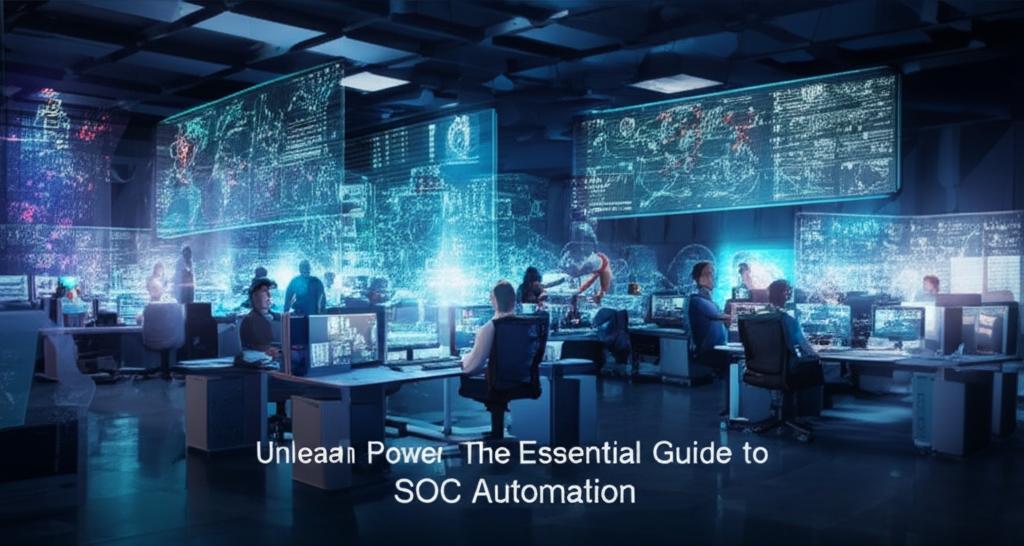Unleash Power: The Essential Guide to SOC Automation
What is SOC Automation?
In today’s rapidly evolving digital landscape, organizations face an unprecedented volume and sophistication of cyber threats. Security Operations Centers (SOCs) are the frontline defenders, tirelessly monitoring, detecting, and responding to these threats. However, the sheer scale of alerts and manual tasks can overwhelm even the most dedicated teams, leading to alert fatigue, missed threats, and delayed responses. This is where SOC Automation steps in as a game-changer.
At its core, SOC Automation refers to the strategic implementation of technology and processes to streamline, standardize, and accelerate various security operations tasks that would traditionally be performed manually. It leverages tools like artificial intelligence, machine learning, and orchestration platforms to handle repetitive, high-volume, and time-sensitive activities, freeing up human analysts for more complex and strategic work.
The Core Purpose of SOC Automation
The primary objective of SOC Automation is to enhance the overall efficiency and effectiveness of a security operations center. It aims to:
- Reduce Alert Fatigue: By automatically triaging, correlating, and enriching security alerts, automation filters out noise and prioritizes genuine threats.
- Accelerate Threat Detection: Automated systems can process vast amounts of data much faster than humans, identifying patterns and anomalies indicative of threats in real-time.
- Speed Up Incident Response: Orchestrated playbooks can initiate containment, eradication, and recovery actions automatically, significantly reducing the mean time to respond (MTTR).
- Improve Consistency: Automation ensures that security processes are executed uniformly every time, minimizing the risk of human error.
Key Components and Technologies Powering SOC Automation
Effective SOC Automation relies on the integration of several advanced cybersecurity technologies:
- Security Information and Event Management (SIEM): Collects and aggregates log data from various sources across the IT infrastructure, providing a centralized view for security analysis. Automation enhances SIEM by correlating events and initiating automated responses based on predefined rules.
- Security Orchestration, Automation, and Response (SOAR): These platforms are the backbone of SOC automation. SOAR tools orchestrate different security tools and execute automated playbooks (pre-defined workflows) for incident response, threat hunting, and vulnerability management.
- Artificial Intelligence (AI) and Machine Learning (ML): AI/ML algorithms are used for anomaly detection, behavioral analytics, threat prediction, and intelligent alert prioritization, making automation smarter and more adaptive.
- Threat Intelligence Platforms (TIPs): Integrates with automated systems to provide up-to-date information on known threats, IOCs (Indicators of Compromise), and attacker tactics, techniques, and procedures (TTPs).
- Endpoint Detection and Response (EDR) / Extended Detection and Response (XDR): Provides deep visibility and automated response capabilities at the endpoint and across broader domains.
Unpacking the Transformative Benefits of SOC Automation
Implementing SOC Automation delivers a multitude of advantages for organizations:
- Enhanced Efficiency and Speed: Automating repetitive tasks allows security teams to handle more incidents with fewer resources, significantly reducing response times from hours to minutes or even seconds.
- Improved Accuracy and Reduced Human Error: Machines follow rules precisely, eliminating inconsistencies and errors often associated with manual processes, leading to more accurate threat identification and response.
- Cost Reduction: By optimizing resource allocation and reducing the need for extensive manual effort, automation can lead to significant operational cost savings.
- Better Threat Posture: Faster detection and response capabilities strengthen an organization’s overall security posture, making it more resilient against sophisticated attacks.
- Empowered Analysts: Free from mundane tasks, human analysts can focus on high-value activities like threat hunting, strategic planning, and complex incident analysis, leading to greater job satisfaction and skill development.
Overcoming Challenges in SOC Automation Implementation
While the benefits are clear, successful SOC Automation implementation isn’t without its challenges:
- Initial Setup Complexity: Integrating disparate security tools and defining effective playbooks requires significant upfront planning and expertise.
- False Positive Management: Poorly configured automation can generate a high volume of false positives, eroding trust and creating new forms of alert fatigue.
- Maintaining Human Oversight and Expertise: Automation should augment, not replace, human intelligence. Analysts must remain in the loop, guiding and validating automated actions.
- Integration Hurdles: Ensuring seamless communication between various security tools and platforms can be technically challenging.
The Future of Security Operations with Automation
SOC Automation is not merely a trend; it’s a fundamental shift in how cybersecurity is managed. As threats continue to evolve and become more automated themselves, organizations that embrace automation will be better equipped to defend themselves. The future SOC will be a highly orchestrated environment where human expertise is amplified by intelligent automation, leading to a proactive and adaptive defense strategy.
Conclusion: Embracing SOC Automation
Ultimately, SOC Automation is an indispensable tool for any organization serious about strengthening its cybersecurity defenses. By harnessing the power of automation, security teams can move beyond reactive firefighting to a more strategic, efficient, and proactive stance, ensuring a safer digital future.







